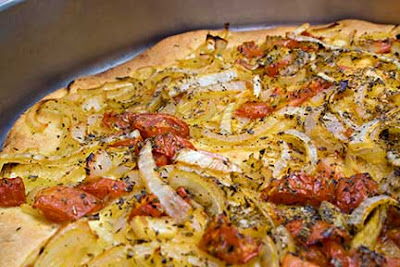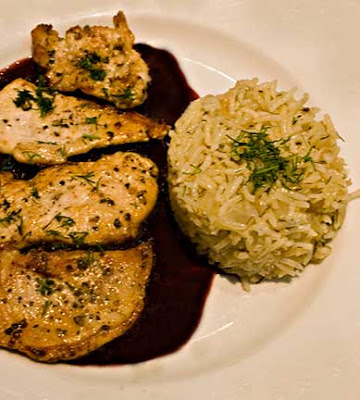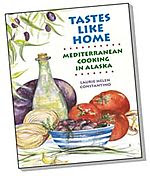 Cephalonia, a Greek island in the Ionian Sea, is famous throughout the world for its meat pies.
Cephalonia, a Greek island in the Ionian Sea, is famous throughout the world for its meat pies.
In recent years, Cephalonia has also become known as the beautiful setting for the novel (and movie) Corelli’s Mandolin by Louis De Bernières (Pantheon Books 1994).
Corelli’s Mandolin opens in Cephalonia during the early years of World War II, shortly before the invasion of Greece. In those years, despite the hovering threat of war, life on Cephalonia continued unchanged. A procession celebrating the death of St. Gerasimos, the patron saint of Cephalonia, was held as it had been for the last hundred years:
“Outside in the beautiful meadows of the valley and amongst the plane trees that lined the road from Kastro, pilgrims and Corybants had been arriving for two days, some of them from distant parts indeed. … The pews were filled with distant acquaintances renewing their friendship by means of the animated and voluble conversation that non-Greeks mistakenly construe as irreverence. Outside, the pilgrims unloaded animals laden with feta, melons, cooked fowl, and Cephalonian meat pie, shared it with their neighbors, and composed epigrammatic couplets’ at each others’ expense. Groups of laughing girls strolled about, arm in arm, smiling sideways at potential husbands and possible sources of flirtation, and the men, pretending to ignore them, stood about in knots, gesticulating and waving bottles as they solved the outstanding problems of the world.“ Corelli’s Mandolin at p. 74 - 75.
Eight days after the celebration of St. Gerasimos described by De Bernières, the Italian dictator Mussolini demanded that Greece allow Italy to occupy certain strategic parts of the country. On October 28, 1940, the Greek prime minister refused this demand and Italy immediately invaded Greece. (Today, October 28 is a Greek national holiday honoring the 1940 refusal to submit to foreign tyranny.)
Although the Greek army held off the Italians, the country fell when Germany joined the battle. Greece was occupied by a joint force of Germans, Italians, and Bulgarians for the duration of World War II. Corelli’s Mandolin describes life in occupied Cephalonia.
Captain Antonio Corelli was a reluctant officer of the Italian garrison on Cephalonia. The fictional Captain Corelli loved music, culture, and his mandolin. Corelli tried to be a benevolent member of the occupation. He was quartered in the home of the town’s doctor and eventually fell in love with Pelagia, the doctor’s daughter.
When the doctor became aware that Pelagia was in love with Corelli, he tried to dissuade her from consummating the affair. The doctor warned Pelagia of the many dire consequences, tangible and intangible, that could result from consorting with an Italian occupier.
Leaving Cephalonia and forsaking its meat pies were some of those consequences: “Are you ready to leave this island and this people? What do you know of life over there? Do you think that Italians know how to make meat pie and have churches dedicated to St. Gerasimos? No, they do not.” Corelli’s Mandolin at p. 281
Corelli’s Mandolin is ultimately the story of Pelagia’s life and the life of Cephalonia, and how both survived the upheaval brought by war. De Bernières used Cephalonian meat pie (Kreatopita) in describing idyllic island life before the war and, when Pelagia is at a crossroads that could lead her away from the island, as a symbol of all that is good about Cephalonia.
The phrase “Cephalonian meat pie” encompasses a multitude of recipes. Most households on Cephalonia have their own version of this delicious dish. In Prospero’s Kitchen: Mediterranean Cooking of the Ionian Islands from Corfu to Kythera, Diana Farr Louis and June Marinos say, “Recipes for Kreatopita in Cephalonia are like recipes for bouillabaisse in Marseille: each one is offered as the only truly authentic version handed down by a mythical grandmother.”
Louis and Marinos describe Kreatopita recipes with prunes, raisins, almonds, and pine nuts. Some recipes use rice, others potatoes; some use marjoram, others oregano. Some Kreatopitas are made with goat, beef, pork, or lamb, and still others with a combination of two or three different meats. Some recipes add hard-boiled eggs to the filling. Louis and Marinos conclude, “It all boils down to a matter of taste.”
Here is the version of Kreatopita that suits my taste. It is based on one I had many years ago at an Athens restaurant that no longer exists. I’d forgotten this dish until recently, when I ate it in a dream and woke up with the taste of Kreatopita in my mouth. The garlic yogurt accompaniment, while not traditional, is how the Kreatopita was served in my dream. It provides a wonderful counterpoint to the meat pie.
For company, I prefer making Kreatopita in 4 - 4 1/2” tart pans (with removable bottoms) so that each person gets their own individual pie. The individual pies may also be frozen whole, to serve later for easy meals. One large meat pie is equally good for serving a crowd, and easier to make than individual pies.
 Cephalonian Meat Pie (Κεφαλονίτικη Κρεατόπιτα)
Cephalonian Meat Pie (Κεφαλονίτικη Κρεατόπιτα)
Makes eight 4 1/2” pies or one 10” pie
Cephalonian Meat Pie may be made with pork, beef, lamb, or a combination of some or all of these meats. It may also be made with leftover roast. (If using leftovers, start by sautéing the onions, and add the cooked meat along with the tomatoes, herbs, and spices.)Traditionally, kefalotyri cheese is used for Kreatopita, but any firm cheese may be substituted. I most recently made this with P’tit Basque sheep cheese, and its earthy flavor paired well with the cinnamon-scented meat.
Using a little butter in the crust (filo) isn’t traditional, but it adds good flavor and flakiness. Olive oil can fully replace the butter, and the crust will still be tasty, but slightly tougher. More water is needed to make the crust if butter is left out. The dough may also be made by hand. If mixing by hand, make sure the olive oil is evenly distributed in the flour and use a fork or pastry cutter to add the butter.
Crust (Filo):
3 cups flour
1/2 tsp. salt
1/2 cup olive oil
1/4 cup cold butter, cut into small chunks
1/3 – 2/3 cup ice water
Filling:
2 pounds meat, cleaned of all bones, fat, and gristle
1/4 cup olive oil
Salt
Freshly ground black pepper
4 cups diced onions, 1/2” dice
2 Tbsp. minced garlic
2 tsp. Aleppo pepper or 1 tsp. crushed red pepper
3 cups ground tomatoes, fresh or canned
1 cup red wine
1 cup beef or chicken stock
1 cinnamon stick
1 tsp. allspice
1/2 tsp. nutmeg
1 Tbsp. dried oregano, crushed
3 bay leaves
1 pound peeled and diced waxy potatoes (red or Yukon gold), 1/2” dice
1 cup minced fresh parsley
2 cups grated kefalotyri, kasseri, or other firm cheese
For the crust: In a food processor, mix the flour, salt, and olive oil until the olive oil is thoroughly incorporated into the flour. Add the butter and pulse three or four times to break up and distribute the butter; when you are done, the butter pieces should be the size of small lentils. Add 1/3 cup ice water and pulse to mix. Pinch together some of the dough to see if it holds together. If it does not, add small amounts of water, pulsing to mix, until the dough holds together when pinched.
Dump the dough onto a piece of plastic wrap and knead lightly until the dough holds together. If you are making individual pies, separate the dough into sixteen pieces, shape the pieces into flat disks, wrap in plastic wrap, and refrigerate for at least 30 minutes. If you are making one large pie, separate the dough into two pieces, shape them into flat disks, wrap in plastic wrap, and refrigerate for at least 30 minutes.
For the filling: Dice the meat into 1/2” pieces, and season it with salt and freshly ground black pepper. Sauté the meat in olive oil until it is browned on all sides. Stir in the onions, and continue to sauté until the onions soften and begin to turn golden. Stir in the garlic and Aleppo pepper and sauté for 1 minute.
Stir in the tomatoes, wine, stock, cinnamon stick, allspice, nutmeg, oregano, bay leaves, salt, and freshly ground black pepper. Bring to a boil, reduce the heat, and simmer for 30 minutes. Stir in the potatoes and continue to cook until the sauce is rich and thick (it is not necessary to fully cook the potatoes). Taste, and add salt, freshly ground black pepper, or oregano, as needed. Let cool. (The filling may be made ahead to this point.) After the filling has cooled a little, stir in the parsley.
Preheat oven to 400°F.
Roll out the bottom crusts (or crust if you are making one large pie) and press into the bottoms and sides of the tart pans (the bottom crust needs to overhang the pan). Divide the filling between the pans, and top with the grated cheese. Roll out the top crusts and place over the filling. Trim the edges of dough if they are too long, roll the edge of the bottom crust over the top crust, crimp the two crusts together, and tightly seal the edges. Use a sharp knife to cut a slit in the top crust; this will allow steam to escape as the Kreatopita bakes.
Bake for 45 - 50 minutes, until the top of the pies are golden brown. (If you are making one large pie, cook for 45 minutes at 400°F, turn the heat down to 350°F, and cook for 30 minutes more. Cover the edges of the pie with foil if they get too dark.)
Serve with Garlic Yogurt on the side, a crisp green salad, dried black olives, and crusty bread.
Garlic Yogurt
2 cups whole-milk yogurt
4 cloves garlic
1 tsp. coarse-grained salt
1 Tbsp. white wine vinegar
2 Tbsp. olive oil
Line a colander with paper towels. Dump the yogurt into the lined colander and let the liquid drain out of the yogurt for 30 – 60 minutes. Puree the garlic by mashing it into the salt. Mix together the drained yogurt, mashed garlic, salt, vinegar, and olive oil. Taste and adjust the seasoning by adding garlic, salt, or vinegar, as needed.
~~~~~~~~~~~~~~~~~~~~~~~~~~~~~~~
This is my entry for Novel Food sponsored by Simona of Briciole and Lisa of Champaign Taste. Simona's half of the wonderful round-up is here and Lisa's half is here.
 Fig Tapenade
Fig Tapenade
 Spicy Squash Soup (Σούπα με Kολοκύθα)
Spicy Squash Soup (Σούπα με Kολοκύθα)
 Rosemary Bread (Ψωμί με Δενδρολίβανο)
Rosemary Bread (Ψωμί με Δενδρολίβανο) ~~~~~~~~~~~~~~~~~~~~~~~~~~~~
~~~~~~~~~~~~~~~~~~~~~~~~~~~~ Pan Seared Scallops Piccata (Χτένια Πικάντικο)
Pan Seared Scallops Piccata (Χτένια Πικάντικο)
 The menu shows we ate well in 1998: gravlax, oysters, clams, calamari, shrimp, king crab, and scallops were all part of the meal. Although the food was just as good, this year’s Christmas Eve dinner was no match for 1998, when much of my family was happily together and the food was joyously cooked with my sister. I’ll remember the 1998 meal for the rest of my life.
The menu shows we ate well in 1998: gravlax, oysters, clams, calamari, shrimp, king crab, and scallops were all part of the meal. Although the food was just as good, this year’s Christmas Eve dinner was no match for 1998, when much of my family was happily together and the food was joyously cooked with my sister. I’ll remember the 1998 meal for the rest of my life.

 Periwinkles in Dill-Onion Wine Broth (Όστρακα “της Πλώρις”)
Periwinkles in Dill-Onion Wine Broth (Όστρακα “της Πλώρις”) Spicy Pesto Grilled Shrimp (Γαρίδες με Πικάντικο Πέστο)
Spicy Pesto Grilled Shrimp (Γαρίδες με Πικάντικο Πέστο) At the time, Tuna Tartare was one of Aqua’s signature dishes, and rightly so. It was beautifully presented: a pile of chopped sashimi grade ahi tuna in the middle of a white plate, surrounded by piles of spices, perfectly ripe pears, mint, and habanero chiles, topped with a quail egg and dressed with sesame oil. With two spoons, the server mixed all the ingredients together tableside, and gracefully created a mountain of tuna tartare in the center of the plate, accented by toast points.
At the time, Tuna Tartare was one of Aqua’s signature dishes, and rightly so. It was beautifully presented: a pile of chopped sashimi grade ahi tuna in the middle of a white plate, surrounded by piles of spices, perfectly ripe pears, mint, and habanero chiles, topped with a quail egg and dressed with sesame oil. With two spoons, the server mixed all the ingredients together tableside, and gracefully created a mountain of tuna tartare in the center of the plate, accented by toast points. Tuna Tartare with Mint, Sesame Oil, and Hot Peppers (Ταρτάρ Τόνου)
Tuna Tartare with Mint, Sesame Oil, and Hot Peppers (Ταρτάρ Τόνου) Alaskan Oysters on the Half Shell with Mignonette Sauce (Στρείδια με Σος Μαυρού Πιπεριού)
Alaskan Oysters on the Half Shell with Mignonette Sauce (Στρείδια με Σος Μαυρού Πιπεριού) Pine Nut Cookies (Biscotti con Pignoli)
Pine Nut Cookies (Biscotti con Pignoli)
 Apple Pancakes
Apple Pancakes



 Christmas Nougat Cookies (Angel Cookies)
Christmas Nougat Cookies (Angel Cookies)


 Maryann's advice came at a time when the local Costco store was carrying flats of huge, gorgeous pomegranates. It was kismet; I had to buy them. Once the pomegranates were piled on my counter, I couldn’t stop thinking about Tom and Joanna’s chicken in pomegranate sauce. I decided to create my own version.
Maryann's advice came at a time when the local Costco store was carrying flats of huge, gorgeous pomegranates. It was kismet; I had to buy them. Once the pomegranates were piled on my counter, I couldn’t stop thinking about Tom and Joanna’s chicken in pomegranate sauce. I decided to create my own version.
 This is my entry for Weekend Herb Blogging #113, hosted this week by Astrid from
This is my entry for Weekend Herb Blogging #113, hosted this week by Astrid from 

